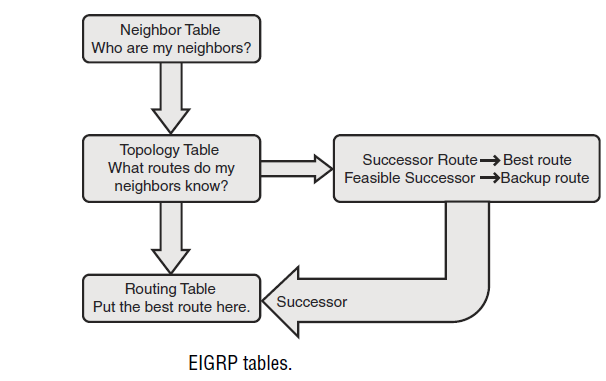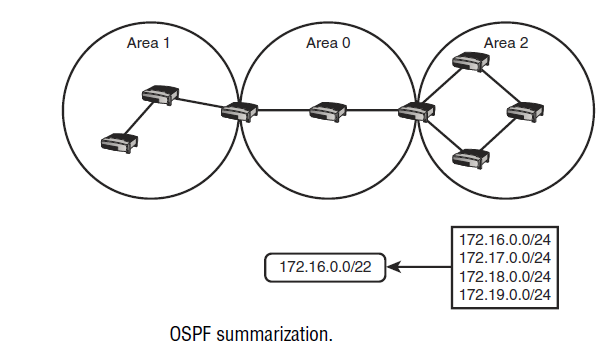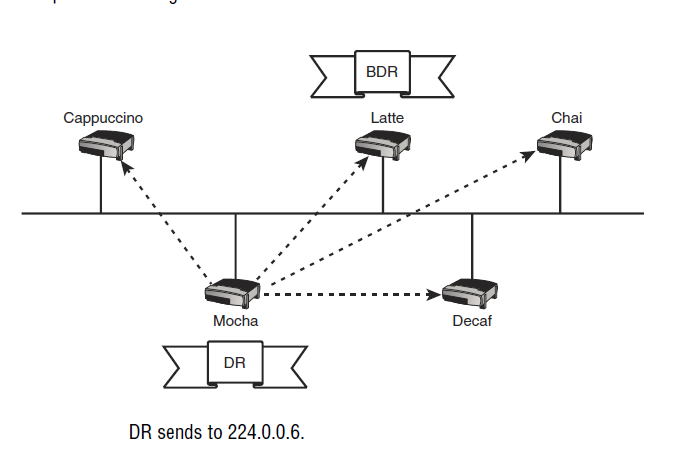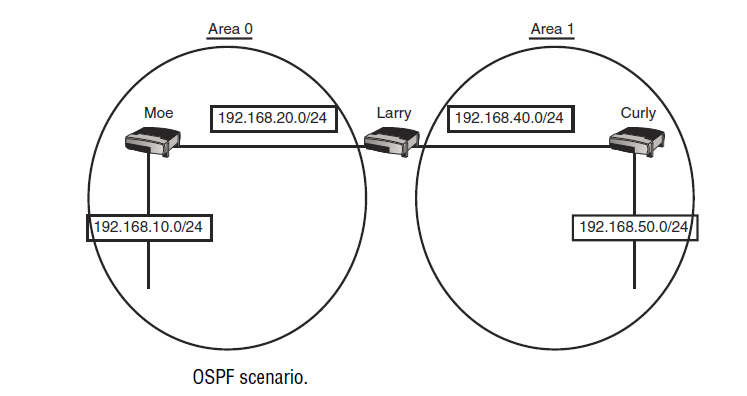
You learned about static, default, and RIP routing.
These are good solutions for small networks but do not scale well. Static routing
becomes prone to errors and is cumbersome to do on a large scale, default routing
does not help in getting to various networks within an enterprise, and RIP routing
has a maximum hop count limitation of fifteen hops. For larger networks you need
a scalable solution. Two good solutions are the Enhanced Interior Gateway
Protocol (EIGRP) and the Open Shortest Path First (OSPF) routing protocols.
EIGRP
EIGRP is a hybrid routing protocol developed by Cisco to replace IGRP. It uses
the Diffusing Update Algorithm (DUAL) developed by Dr. J. J. Garcia-Luna-
Aceves. Similar to RIP, it has a maximum hop count, but its maximum is 224.
Unlike RIP, however, it does not send out periodic updates. Instead, EIGRP
sends updates only when there is a change in the network.
Characteristics of EIGRP
EIGRP uses the bandwidth and delay of an interface by default, with the option
of factoring reliability, load, and MTU. EIGRP maintains three tables, as shown
next:

.
Neighbor table.
Topology table.
Routing tableEIGRP begins by sending HELLO packets out all active interfaces. The router
listens for HELLO packets from other routers. From the HELLO packets, the
router learns of neighboring routers, which get listed in the neighbor table.
After the router knows of its neighbors, it begins exchanging routes with its
neighbors. These routes go into the topology table, which is similar to a routing
table, but no decision has been made yet as to the best route. Instead, the
topology table is used to build a map of the network with different speed limits
(bandwidth) on the different roads (links). The DUAL algorithm is run against
the topology table, and two routes are determined as a result:
.
Successor route—This is the best route as determined by the DUALalgorithm. This route gets injected into the routing table and is the one
used when packets are routed.
.
Feasible successor route—This is the next best route and is kept in thetopology table. It is used only in the event that the primary successor
route goes down.
By having a feasible successor route, the router is ready to instantly inject another
route into the routing table should the successor ever go down. This makes
convergence very rapid with EIGRP.
In addition to being a rapidly converging protocol, EIGRP is the only routing
protocol that supports multiple Layer 3 protocols, namely IP, AppleTalk, and
IPX. All the other routing protocols mentioned in this chapter support only IP.
EIGRP maintains separate tables for each of the three protocols it supports.
Another distinction of EIGRP is its use of two administrative distance values.
EIGRP uses administrative distance 90 for routes learned through EIGRP.
Routes can also be redistributed into EIGRP from another routing protocol.
When this occurs, redistributed routes get an administrative distance of 170.
Internal routes are best described as those that are direct testimony, or trusted
the most, whereas external routes are like hearsay and are therefore trusted less.
Remember the main characteristics of EIGRP:
.
Hybrid protocol.
Supports IP, AppleTalk, and IPX.
Has two administrative distance values, one for internal and one for external(redistributed routes)
.
Uses bandwidth and delay by default in calculating its metric, but can also factorreliability, load, and MTU.
Implementing EIGRP
Basic EIGRP configuration is not that different from configuring RIP. The primary
difference for basic configuration is that you must specify an autonomous
system number that defines your routing domain. The autonomous system
number is assigned globally for the routing process and can be any number you
want, but that same number must be used on all routers. Routing updates will
not be exchanged between routers with different autonomous numbers. Because
the exam focuses heavily on troubleshooting, make sure you always check that
the autonomous numbers match in the exam scenarios.
The following example shows how to configure EIGRP for a router connected
to networks 192.168.10.0/24 and 192.168.20.0/24. The autonomous system
number is 1 and is specified when entering the routing process.
Router(config)#
router eigrp 1Router(config-router)#
network 192.168.10.0Router(config-router)#
network 192.168.20.0Similar to RIP version 2 and OSPF, EIGRP can be a classless routing protocol.
By default, it is classful. To enable classless routing, type the following command
under the routing process:
Router(config-router)#
no auto-summaryVerifying and Troubleshooting EIGRP
A good engineer does not just configure routing but knows to verify the configuration
with
show commands. The most common show command when verifyingyour routing configuration is
show ip route. This command was discussedagain, so it is not discussed here. Keep in mind, though, that this is best
command to use to see whether your routing table is being populated.
You can use other commands besides
show ip route to verify your EIGRP configuration.These include
show ip protocols and show ip eigrp topology.The first command,
show ip protocols, is helpful to see your autonomous systemnumber and the networks you are advertising.
Router#
show ip protocolsRouting Protocol is “eigrp 1”
Outgoing update filter list for all interfaces is not set
Incoming update filter list for all interfaces is not set
Redistributing: eigrp 1
Automatic network summarization is in effect
Routing for Networks:
192.168.0.0
Routing Information Sources:
Gateway Distance Last Update
192.168.1.0 90 0:02:36
192.168.2.0 90 0:03:04
192.168.3.0 90 0:03:04
Distance: internal 90 external 170
Table 14.1 summarizes the important lines of this command.
TABLE 14.1 Summary of Show IP Protocols Output
Output Description
Outgoing/incoming filters Used to filter routing updates between routers.
Redistributing Covered in the Cisco Certified Network Professional (CCNP)
exam. This pertains to redistributing information between
routing protocols and is outside the scope of this exam.
Automatic network Whether the
no auto-summary command has been applied.summarization is in effect In this example, the command has not been applied, and
EIGRP is doing classful routing.
Routing for networks Which networks your router is advertising to other routers.
Routing information sources This defines which routers are sending your EIGRP routes,
the administrative distance for those routes, and the last time
your router received an update from other routers.
Distance The administrative distance for internal and external routes.
The second command is
show ip eigrp topology. As the command suggests,this outputs your topology table. Your topology table contains all the routes
your router knows about. Here is where you will also see your successor (best
routes) and your feasible successor (backup routes):
Router#
show ip eigrp topologyIP-EIGRP Topology Table for process 77
Codes: P - Passive, A - Active, U - Update, Q - Query, R - Reply,
r - Reply status
P 172.16.0.0 255.255.0.0, 2 successors, FD is 36251776
via 172.16.17.1 (36251776/36226176), Ethernet0
via 172.16.18.1 (36251776/36226176), Ethernet1
P 172.20.0.0 255.255.0.0, 1 successors, FD is 307200
via 172.16.81.28 (307200/281600), Ethernet1
via 172.16.19.5 (702311/295210), Ethernet2
From this output you can begin to get an idea of the topology of your network.
Notice that for the 172.16.0.0/16 network you have two successors. This is
because the metric is the same for both networks and, subsequently, you will
load balance across two networks. The metric that is put in the routing table is
the first number in parenthesis (36251776 in this example) and is called the feasible
distance (FD).
The 172.20.0.0 network has only one successor route out Ethernet1 that is
learned from a router with the IP address 172.16.81.28. You also have a backup
route (feasible successor) out Ethernet2 that is learned from a router at
172.16.19.5.
For the exam, make sure you are comfortable analyzing the output of these show
commands.
Active Versus Passive Routes
You will notice in the output of the
show ip eigrp topology command that the routesbegin with a P for passive. According to the legend at the beginning of this output, a route
can also be A for active. A passive route is when your routing table has fully converged.
An active route is when a route has changed and your routers are querying other routers
to discover the change in the topology. Ideally, your routes should be in passive mode.
Another scalable routing protocol is the Open Shortest Path First (OSPF) protocol.
OSPF was developed by the Internet Engineering Task Force (IETF) in
1988 as a more scalable solution than RIP. Unlike EIGRP, OSPF is an open standard
and is not Cisco proprietary. It uses the Shortest Path First (SPF) algorithm
developed by Edgar Dijkstra. It is a link state routing protocol, which means that
it sends updates only when there is a change in the network, and instead of sending
routing updates, it sends link state advertisements (LSAs) instead.
Characteristics
OSPF is a polite protocol. Unlike chatty RIP, which broadcasts out its entire
routing table every 30 seconds regardless of whether other routers want to hear
it, OSPF takes a more gentlemanlike approach to routing. First, OSPF sends
out hello messages to neighboring routers to announce itself as an OSPF router
and discover who its neighbor routers are. Routers have to agree on certain
parameters (such as timers and being on a common subnet) before they can
become neighbors. After its neighbor routers are discovered, they begin to
exchange information about networks (links) it knows about, using messages
called link state advertisements (LSAs). After exchanging all routes, the routers
send out updates only when there is a change, and they send information only
for that affected route, not the entire routing table. Routers take the link state
advertisements heard from other routers and place those routes in its link state
database (similar to the topology database in EIGRP). Routers then run the SPF
algorithm to determine the best route to a destination and place that route in
the routing table.
To determine the best path, OSPF uses a metric called cost, which Cisco defines
as 108/bandwidth. If you had a 100Mbps link, the cost would be 1 because
100,000,000/100,000,000. Here are some other common costs:
.
10Mbps: 10.
1.544Mbps (T1): 64.
64Kbps: 1562These examples are not included just to impress you with the authors’ math abilities.
You should know the formula to determine the cost of a link. Given the bandwidth of
an interface, know how to calculate the OSPF cost.
The bandwidth costs are based on a bandwidth reference of 100Mb. If you have faster
links in your enterprise, such as Gigabit Ethernet, you can change what OSPF bases its
cost on by using the auto-cost reference bandwidth command. For example, to change
your OSPF to use 109/bandwidth (1,000,000 or GB), type the following command
under the router process configuration mode:
Router(config-router)#
auto-cost reference-bandwidth 1000000The SPF algorithm places each router as the “root” of a tree and calculates the
shortest path from itself to each destination. The shortest path then gets put
into the routing table and is used to route packets to their destination.
Hierarchical Routing
An important concept to grasp with OSPF is that it is a hierarchical protocol.
Hierarchical routing protocols break up your autonomous system into multiple
areas and summarize routes between areas. If summarized wisely, you can cut
down a significant portion of routing updates by advertising only the summarized
route.
As the number of networks increases in your domain, the amount of processing
required on each router increases. To lower the amount of processing required,
you can use route summarization. Route summarization looks for the same
sequence of bits used in subnetworks and creates a less-explicit summary route.
For example, Figure 14.2 shows four networks in area 2:
.
172.16.0.0/24.
172.17.0.0/24.
172.18.0.0/24.
172.19.0.0/24

The first octet, 172, is the same for all four routes, but the second octet differs.
By looking for similar bits, we can create a single summary route:
128 64 32 16 8 4 2 1
16 0 0 0 1 0 0 0 0
17 0 0 0 1 0 0 0 1
18 0 0 0 1 0 0 1 0
19 0 0 0 1 0 0 1 1
The bits are the same up to the 4-bit position. Only the 16-bit position is set to
1, so by ignoring the last two bits (because they change), we are left with
172.16.0.0. The subnet mask has changed, however, because we are no longer
working with a /24. Instead, our subnet mask has moved two places to the left
because the last two bit positions vary for the four networks. Our resulting summarized
route is 172.16.0.0/22 (255.255.252.0). This will be the route that gets
injected into area 0 from area 2.
The routers in area 0 and area 1 have to process only the one summarized route
instead of four individual routes. Being able to summarize your routes between
areas provides several benefits:
.
Less processing on routers—This is not only because of the single networkstatement (in contrast to four), but also because of the lack of recalculation
should a more specific network (that is, a /24) go down.
.
Instability hidden from other routers—If a single network goes downin area 2, it will not affect the routers in area 0 and area 1.
.
Fast convergence—Because fewer routes are sent to area 0, the routersin areas 0 and 1 can converge faster.
.
Less bandwidth overhead—There is less bandwidth because only oneroute is sent, so the advertisement is smaller.
.
Greater control over routing updates—Because you gain control overrouting updates, you can control what routes get sent from one area to
another.
You might have noticed that both area 2 and area 1 are connected via area 0.
Area 0 is the “backbone” area in OSPF, and all other areas must be connected to
it. Routes are then summarized into your backbone area.
Designated and Backup Designated Routers
Summarizing is an excellent way to conserve your precious bandwidth. On networks
that contain more than two routers, OSPF can also conserve bandwidth
by electing a designated router for that network that all routers communicate
with. Routers exchange information with a designated router instead of each
other. This cuts down significantly on the number of advertisements.
The process of using a designated router is somewhat complex, so let’s go
through it one step at a time. First, the designated router (DR) is elected on only
two types of networks:
.
Broadcast multi-access—Ethernet, Token Ring.
Nonbroadcast multi-access—Frame Relay, ATM, X.25On a point-to-point network with only two routers, there is no need for this
type of election. Remember that on a point-to-point network, there is no point
(of having a DR).
Second, the DR is not the only type of router elected on these types of networks.
A backup designated router (BDR) is used in the event that a DR should fail.
The DR and BDR election is as follows:
1. The router with the highest priority becomes the DR. The router with
the second-highest priority becomes the BDR. Priority is a number
between 0 and 255 and is configured on an interface with the command
ip ospf priority
priority_number. The default priority is 1, and if therouter is set to priority 0, it will never become a DR or BDR.
2. In the case of a tie, such as when every router’s priority is left to the
default of 1, the tie breaker is the router with the highest router ID.
Every router has an identifier called a router ID (RID) that is used to identify
itself in its messages. The router ID is an IP address and is assigned as follows:
1. The router ID can be configured with the router-id command under
the OSPF routing process. You can choose a valid IP address that you
are using on the router or make up a new one.
2. If the router-id command is not used, the numerically highest IP
address on any loopback interface is chosen as the router ID. A loopback
interface is a virtual, software-only interface that never goes down.
3. If you do not have any loopback interfaces configured, the highest IP
address on any active physical interface is chosen as the router ID.
See if you can spot the router ID given the following IP addresses on a router:
Serial 0/0: 192.168.100.19
FastEthernet 0/0: 10.0.0.1
Loopback 0: 172.16.201.200
Although the highest IP address is the one configured on the serial interface, a
loopback interface takes precedence over any physical interfaces. Therefore, the
router ID would be 172.16.201.200.
The
router-id command is common in the real world, but for the test, make surethat you know the process the router uses to select a router ID if the
router-id commandis not used. It first looks at the highest IP address on any logical (loopback)
interface, and if no loopback interfaces exist, it looks at the highest IP address on any.
Let’s review. On broadcast and nonbroadcast multi-access networks, a designated
router and backup designated router are elected. The election is done by first
choosing the routers with the highest priority value or, if the priorities are same,
choosing the routers with the highest router ID. The router ID is chosen by the
highest IP address on any loopback interface or, if no loopback interfaces are
configured, the highest IP address on any active physical interface. Whew!
That’s a lot of work, but in the end it will conserve a significant amount of bandwidth
by minimizing the number of link state messages.
Now that we have elected a DR and BDR, the next phase is ready to begin. In
Figure 14.3, you see five routers. The Mocha router is the DR, and the Latte
router is the BDR. Instead of all routers sending link state advertisements to
each other, they send out messages only to the DR and BDR. Messages are sent
to the multicast address of 224.0.0.6; both the DR and BDR belong to this multicast
group address.
Next, the Mocha router, which is the DR, takes the information it learned from
the other routers and sends it back out to all routers, as shown in Figure 14.4.
Messages are sent to the All SPF Router multicast address of 224.0.0.5; all routers
running OSPF are members of this multicast group address.


active physical interface.
Implementing OSPF
Understanding the complexities involved in OSPF is the difficult part; configuring
it is fairly straightforward. The process is the same as with the other protocols.
First, we enable the routing protocol. This is done with the command
router ospf <process-id>
. The process ID can be any number you preferbetween 1 and 65,535. Note that this is not the same as the autonomous system
number found in IGRP and EIGRP. Here, the process ID is local to the router
and does not need to match other routers.
The next step is to activate OSPF on your interfaces and advertise your networks.
This is done with the network command as before, but the syntax is a little
different. Here, the syntax is
network
network address wild card mask area area-idNote that you specify a wildcard mask in the configuration. Here, wildcard masks are used to
match the IP address that is being used on an interface.
Take a look at next figure, where we come across our three friends again: Moe,
Larry, and Curly. Given this example, the configuration for Moe would be
Moe(config)#
router ospf 1Moe(config-router)#
network 192.168.10.0 0.0.0.255 area 0Moe(config-router)#
network 192.168.20.0 0.0.0.255 area 0Cappuccino Latte Chai
Decaf
DR
BDR
Mocha
Larry’s configuration would beLarry(config)#
router ospf 1Larry(config-router)#
network 192.168.20.0 0.0.0.255 area 0Larry(config-router)#
network 192.168.40.0 0.0.0.255 area 1Finally, Curly’s configuration would be
Curly(config)#
router ospf 1Curly(config-router)#
network 192.168.40.0 0.0.0.255 area 1Curly(config-router)#
network 192.168.50.0 0.0.0.255 area 1

The wildcard mask used in t
The wildcard mask used in these statements is matching the IP
address on theinterface. Here, we are matching the entire network, of which the IP address is
a part. For example, on Curly’s router, the command
network 192.168.40.00.0.0.255 area 1
tells the router to match all addresses that begin with192.168.40. The last octet, which has 255 in the wildcard mask, is ignored. The
router examines the IP addresses of its directly connected interfaces and activates
OSPF on those interfaces that match the statement.
Because you are using wildcard masks to match the IP address on your directly
connected interfaces, you could also use the wildcard mask of 0.0.0.0 to match
the exact address. Just as with IP access lists in Chapter 13, a wildcard mask of
0.0.0.0 would match a specific address. For example, if Curly had the IP address
of 192.168.40.1 on one interface and 192.168.50.1 on another interface, you
could configure Curly’s router using a wildcard mask of 0.0.0.0:
Curly(config)
router ospf 1Curly(config-router)#
network 192.168.40.1 0.0.0.0 area 1Curly(config-router)#
network 192.168.50.1 0.0.0.0 area 1Using a wildcard mask that matches the IP address of the interface is equivalent
to using a wildcard mask that matches the network where the IP address resides.
For the exam, focus on matching the entire network (0.0.0.255 wildcard mask in
the previous example); the reasons behind which one you should choose are outside
the scope of this book and, for that matter, the exam.
EXAM ALERT
The syntax for OSPF is slightly different from other routing protocols. Make sure that
you feel comfortable configuring OSPF. Remember, it uses a process ID, not an
autonomous system. Also, OSPF uses wildcard masks and not subnet masks in its
configuration.
There are two optional commands that you should be familiar with for the
CCNA exam. These commands, configured under the interface, are
.
ip ospf priority priority_number—This is used to change the priorityof an interface for the DR/BDR election.
.
ip ospf cost cost—This is used to manually change the cost of aninterface.
Verifying and Troubleshooting OSPF
For verification, you can use the
show ip protocols and show ip route asbefore. Other commands you can use to verify your configuration are
.
show ip ospf interface—This command displays area ID andDR/BDR information.
.
show ip ospf neighbor—This command displays neighbor information.You can use the
debug ip ospf events command to troubleshoot OSPF. Thiscommand is helpful to troubleshoot why routers are not forming a neighbor
relationship with each other. Similar to EIGRP, OSPF routers form neighbor
relationships before exchanging any routing information. Several items must
line up, however, for a neighbor adjacency to be established:
.
Timers must be the same on both routers. OSPF uses hello timers thatdefine how often they send out hello messages and dead timers that
define how long after a router stops hearing a Hello message does it
declare its neighbor as down.
.
Interfaces connecting the two routers must be in the same area..
Password authentication, if being used, must be the same..
Type of area must be the same. (This last item is outside the scope of theCCNA test, but it is covered on the CCNP BSCI exam.)
Neighbors are formed automatically or can be established through the use of the
neighbor
command done under the routing process. Sometimes the neighboradjacency does not form, and the
debug ip ospf events command can help youto troubleshoot what is going wrong. The following debug output shows an
example of an adjacency not forming because of two routers having different
timers configured:
Router#
debug ip ospf eventsOSPF: hello with invalid timers on interface FastEthernet0/0
hello interval received 10 configured 10
netmask received 255.255.0.0 configured 255.255.0.0
dead interval received 40 configured 60
To maintain consistency throughout your network, you should set the same bandwidth
reference across on all your routers.